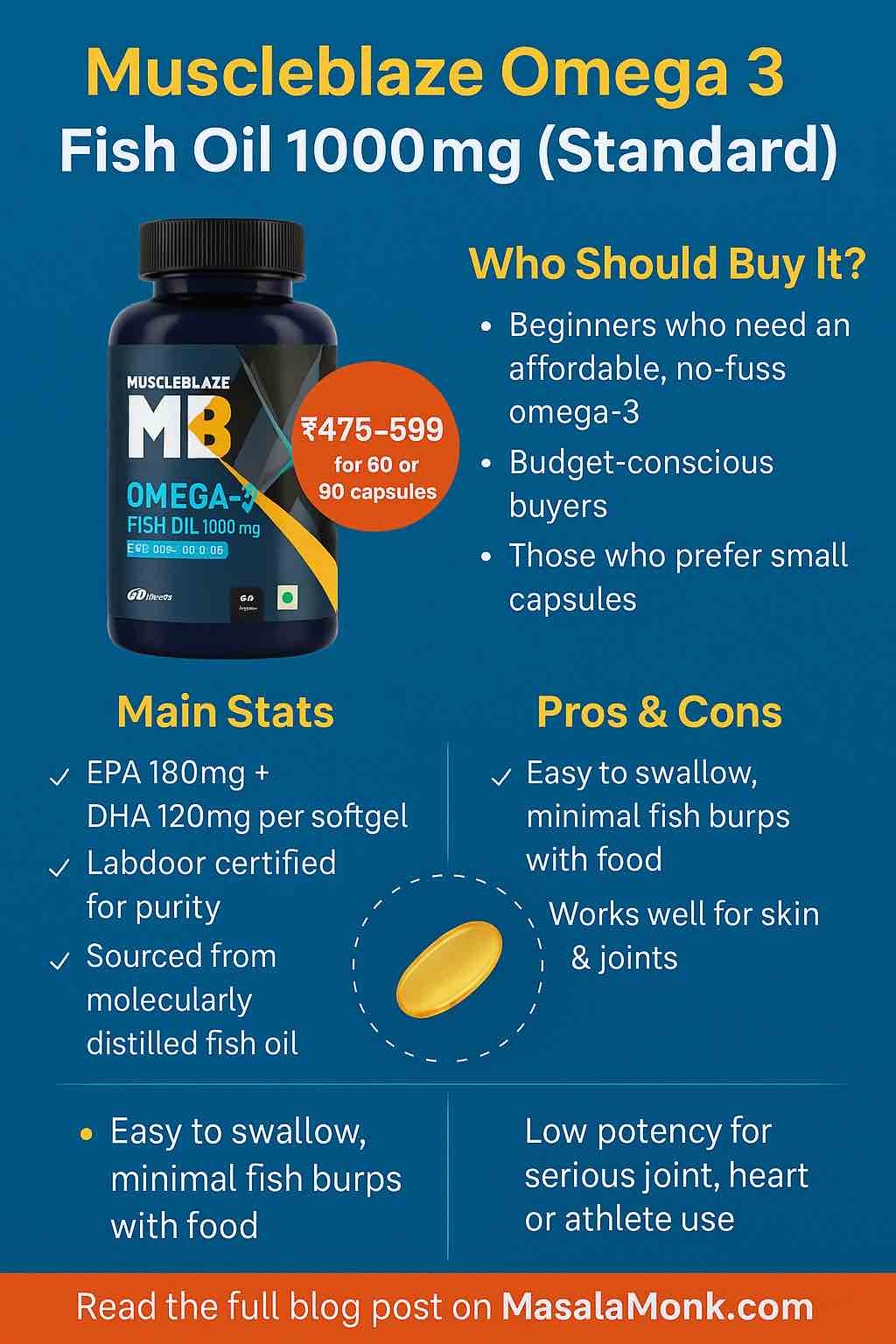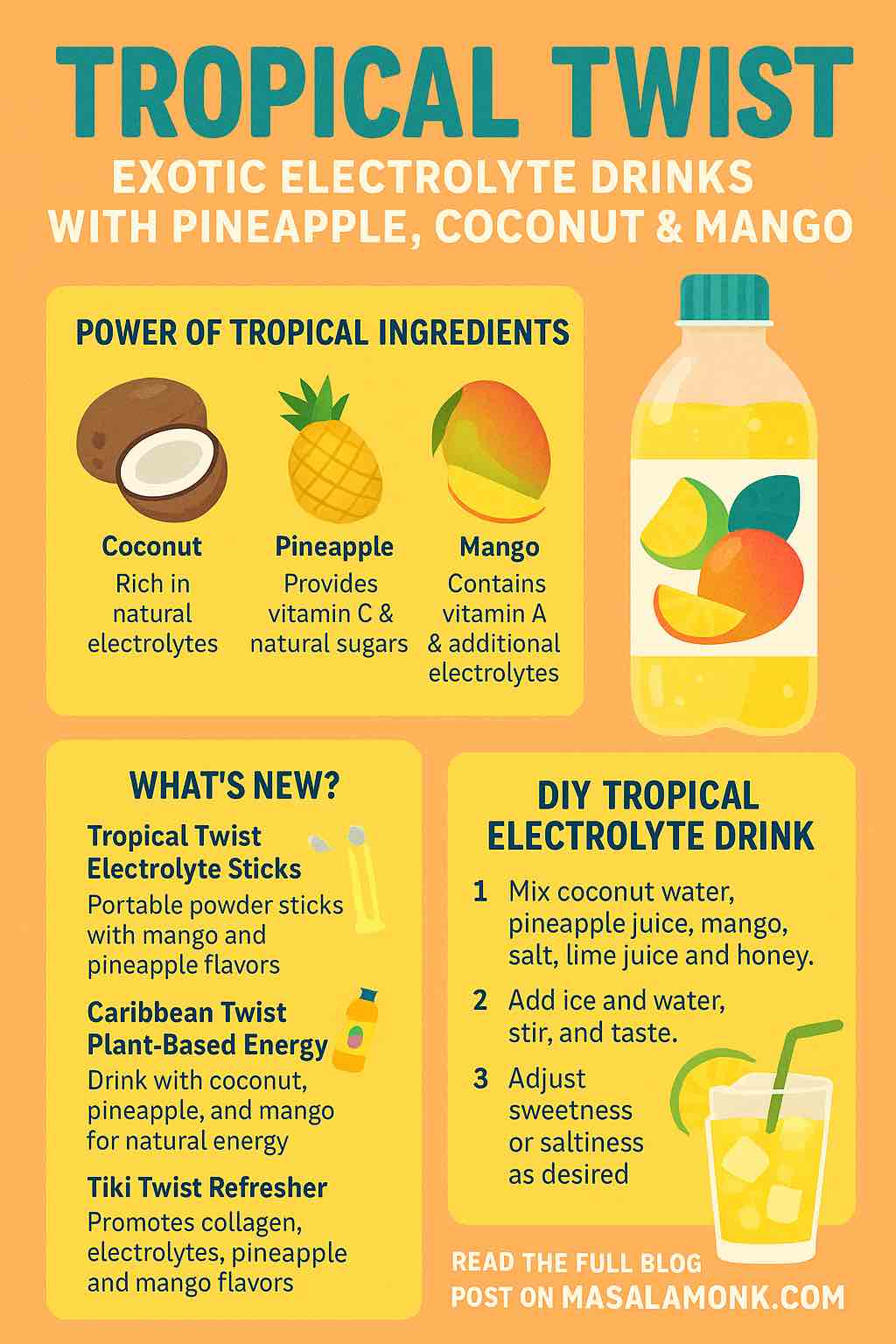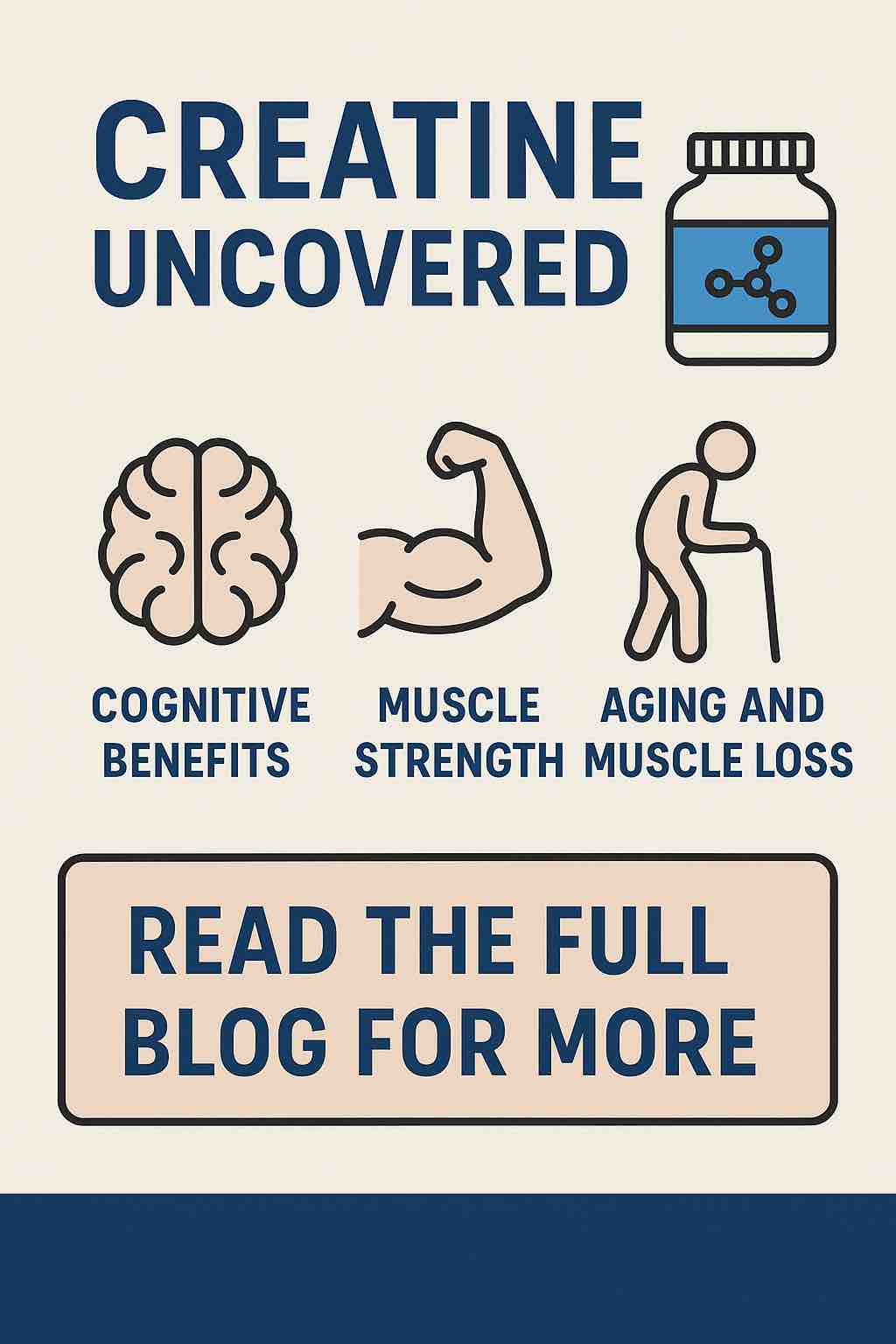
Why Fish Oil—And Why MuscleBlaze?
Omega-3s are one of the most universally recommended supplements for modern health:
They’re proven to help with heart health, cognitive clarity, inflammation, skin, and joint pain. But typical Indian diets are low in EPA and DHA—the most potent omega-3s. This is why fish oil capsules have gone from a “fitness freak thing” to a mainstream health essential.
Among dozens of choices on Amazon India, MuscleBlaze Omega 3 Fish Oil 1000mg stands out for one reason:
It’s a certified, budget-friendly, no-fuss daily omega-3 from a trusted Indian brand.
But what do you really get with the “Standard” version?
Is it good enough, and who is it actually best for?
Let’s break it all down—from ingredient label to real user experience.
Want to see all the top fish oil supplements in India? Check our in-depth comparison of 7 brands here.
Product Snapshot: MuscleBlaze Omega 3 Standard (1000mg)
- Each Capsule: 1000mg fish oil (180mg EPA, 120mg DHA, ~700mg “other” omega-3s)
- Capsule Size: Small, vanilla-flavored softgel
- Typical Price: ₹350–₹599 for 60/90 capsules (see current Amazon price)
- Purity Certification: Labdoor USA and Trustified (heavy metals, purity, label accuracy)
- Source: Anchovy oil, molecularly distilled
- Form: Bovine gelatin softgel (not vegetarian/vegan)
- Manufactured by: Maxcure Nutravedics, trusted for major sports nutrition brands in India
Unpacking the Ingredients: What Are You Really Getting?
This is where most brands play games.
“1000mg fish oil” doesn’t mean “1000mg EPA+DHA.” In reality, most of that number is generic fish oil.
What matters for your health? EPA and DHA content.
MuscleBlaze Standard per softgel:
- EPA (Eicosapentaenoic Acid): 180mg
- DHA (Docosahexaenoic Acid): 120mg
- Other Omega-3s: ~700mg
This is the classic ratio for most budget fish oil products. For basic wellness, skin, mood, heart, and everyday inflammation, this dosage is a solid start.
But if you want athletic recovery, joint repair, or clinical doses for cholesterol, you’ll need to double or triple up—or try a high-potency fish oil like MuscleBlaze Gold Triple Strength (see more below).
Want more on what omega-3 does in your body? See our science-backed fish oil benefits guide.
The MuscleBlaze Difference: Certification, Safety, and Sourcing
Not all fish oil is created equal—cheap products can be oxidized, contaminated, or under-dosed.
MuscleBlaze Standard gets its credibility from:
- Labdoor USA certification: Third-party tested for purity, safety, and “does what it says on the label.”
- Trustified badge on Amazon: An extra layer of authenticity and consumer trust.
- Molecular distillation: Removes heavy metals, mercury, and toxins—crucial for long-term use.
Result: No hidden nasties, no worry about Indian regulatory shortcuts. This is as good as fish oil gets in the sub-₹600 range.
Real User Experience: Reviews and What to Expect
What Real Buyers Say
- Positive:
- “Easy to swallow, small capsules. No fishy burps for me, very effective for skin and joint pain.”
- “Good quality, helps my dad with knee stiffness and general energy.”
- “Best price for a lab-certified fish oil. Using it daily, and my blood markers improved after 6 months.”
- Neutral to Mixed:
- “Capsule is easy but if I take on an empty stomach, I sometimes burp a fishy taste—much better if taken with breakfast.”
- “Didn’t see a miracle overnight, but less joint cracking and slightly better focus over 1-2 months.”
- Negative:
- “Still got fishy burps if I forgot to eat with the capsule.”
- “Not vegetarian and not for strict religious diets.”
Key Takeaways
- Capsule Size: Much smaller than “triple strength” or import brands. Easy for most users, even those who hate big pills.
- Taste/Aftertaste: Vast majority report little or no fishy taste if taken with food. If you do get aftertaste, just time it with a heavier meal.
- Digestibility: No bloating or discomfort for most, but a small group with very sensitive stomachs might feel mild upset if taken on empty stomach.
- Results Timeline: No “supplement magic”—expect subtle but real benefits after a month or more. Consistency is key.
Practical Usage Guide
- How many capsules?
For general wellness, 1 capsule daily is enough.
If your doctor recommends 500mg+ EPA/DHA for heart/joint support, use 2–3 capsules spaced with meals—or opt for a triple strength fish oil. - When to take?
Always with a meal—ideally your largest meal of the day. - How to store?
Room temp is fine for most Indian homes. If you live in a very hot or humid area, keep it in the fridge (never freeze). - What to avoid?
Don’t combine with other fish oil or cod liver oil unless your physician approves.
Comparison: Is MuscleBlaze Standard Enough, or Should You Upgrade?
| Product & Link | EPA / DHA per Cap | Price (60 caps) | Ideal For |
|---|---|---|---|
| MuscleBlaze Standard | 180 / 120 mg | ₹475–₹599 | Beginners, daily health, small capsules |
| MuscleBlaze Gold Triple Strength | 500 / 400 mg | ~₹875 | Athletes, joint support, high-dose, value |
| Wellbeing Nutrition Omega 3 | 612 / 408 mg | ~₹948 | Slow-release, curcumin, advanced users |
| Carbamide Forte Triple Strength | ~495 / ~330 mg | ~₹699 | Big dose, big savings, bestseller |
| TrueBasics Omega 3 | 525 / 375 mg | ~₹649 | Balanced, moderate strength |
| Tata 1mg Omega 3 | 560 / 400 mg | ~₹715 | Budget potency, regular health |
| Neuherbs Deep Sea Omega 3 | 892 / 594 mg | ~₹1,200 | Premium, max strength, advanced needs |
Need an overview of all the best options? Read our ultimate fish oil supplement comparison for India.
When MuscleBlaze Standard Makes Sense
- You’re new to supplements: Not sure if fish oil is for you? Start here before upgrading.
- On a budget: For under ₹600 a month, it’s unbeatable for certified omega-3.
- Smaller capsule preferred: If you or a family member have trouble with big pills, this is much easier than most “triple strength” capsules.
- General wellness: You want a safe, steady boost for heart, brain, skin, and joint health.
When You Should Choose a Higher-Dose Fish Oil
- Athletes, fitness junkies, or people with specific health recommendations: You want 500mg+ EPA/DHA daily for joint pain, inflammation, muscle recovery, or heart/lipid support.
- One-capsule convenience: Want it all in one softgel? Go for MuscleBlaze Gold Triple Strength or see all advanced fish oil options here.
Value for Money
- Cost per 100mg of EPA+DHA: One of the lowest in the Indian market (even compared to many imports).
- Lab-tested purity: No mystery ingredients or quality doubts.
- Scalable dosage: Easy to adjust by taking more capsules if needed—though at a certain point, a triple-strength product is more cost-effective.
Final Word: Is MuscleBlaze Standard Fish Oil Worth It?
For most Indian adults seeking an affordable, safe, and reliable omega-3 boost, the answer is yes.
You’re getting lab-verified purity, trustworthy sourcing, and a gentle-on-the-stomach capsule with minimal taste complaints.
It’s the best “entry level” fish oil for daily use in India, and perfect for anyone wanting to build an evidence-based supplement routine without overpaying.
If you want the best per-pill potency, check out MuscleBlaze Gold Triple Strength or our expert comparison of 7 top Indian fish oils.
Ready to order or learn more?
👉 Buy MuscleBlaze Standard Fish Oil on Amazon India
Further Reading and Resources
- What Is Fish Oil Good For? (benefits, side effects, and more)
- Best Fish Oil Supplements on Amazon India – Top 7 Brands Compared
- MuscleBlaze Gold Triple Strength Omega 3
- Wellbeing Nutrition Omega 3
- Carbamide Forte Triple Strength
- TrueBasics Omega 3
- Tata 1mg Omega 3
- Neuherbs Deep Sea Omega 3
This review is for educational purposes. Always consult your physician before starting any new supplement—especially if you have a medical condition or take medication.
10 FAQs for MuscleBlaze Omega 3 Fish Oil 1000mg (Standard)
1. What is the recommended daily dose for MuscleBlaze Omega 3 Fish Oil 1000mg (Standard)?
Take one softgel daily with your main meal. For higher EPA/DHA needs (e.g., joint or heart health), you may take 2-3 capsules, but consult your doctor for high-dose use.
2. Will I get fishy burps or aftertaste from this supplement?
Most users report little to no aftertaste if taken with food. A small number experience mild fishy burps, especially if taken on an empty stomach.
3. Can vegetarians or vegans use this product?
No, it is made from fish oil (anchovy) and contains a bovine gelatin capsule. Look for algae-based omega-3s for vegetarian/vegan needs.
4. Is MuscleBlaze Omega 3 Fish Oil 1000mg safe for long-term use?
Yes, it is safe for most healthy adults when used as directed. Consult your physician if you are pregnant, breastfeeding, have bleeding disorders, or are on medication.
5. How does the standard version compare to MuscleBlaze Gold Triple Strength?
The standard version contains 180mg EPA + 120mg DHA per capsule, while Gold Triple Strength offers 500mg EPA + 400mg DHA. The Gold version is better for high-potency needs and one-capsule convenience.
6. Can I take this fish oil with other supplements or medicines?
You can take it with most multivitamins or protein supplements. If you’re on medication, especially blood thinners, consult your doctor before use.
7. Does this supplement need to be refrigerated?
No, store it in a cool, dry place away from sunlight. In very hot or humid climates, refrigeration can help maintain freshness.
8. How do I check if my MuscleBlaze bottle is authentic?
Scratch the code on your bottle and verify it on the MuscleBlaze website or follow instructions on the packaging. Always buy from trusted sellers.
9. Is this fish oil suitable for children or seniors?
It can be used by older teens and seniors with physician approval. Always consult a pediatrician for children.
10. How long does it take to notice benefits?
For most users, benefits like joint comfort, better skin, or mood appear after 4–8 weeks of consistent daily use. Cardiovascular and brain benefits are long-term.











